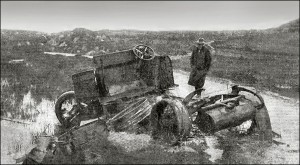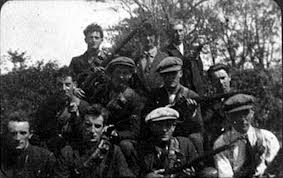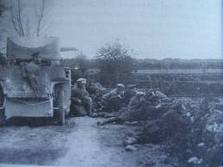Ambushes in the Irish War of Independence: Myth and Reality

By John Dorney
Had it not been for the public health restrictions currently in force in Ireland (February 2021), there would be a glut of public commemorations of the ambushes of one hundred years ago in 1921.
The ambush, in common English language parlance, can signify a rather cowardly surprise attack on an unsuspecting victim, who is not given a ‘fair fight’. And indeed during the Irish War of Independence, the term was sometimes used by those, British officials, Catholic clergy and others who disapproved of the IRA’s campaign, in this derogatory light.
In the main though, the ‘ambush’ in Irish revolutionary folklore signifies a daring attack by skilled and elusive IRA ‘flying columns’ on Crown forces – a bold riposte by the republican citizen soldiers against the forces of the Crown, using surprise and concealment to cancel out the Crown forces’ advantages in numbers and armament.
The IRA ambush became the distinctive motif of the War of Independence, but this vision is somewhat at odds with the reality.
When retelling the story of the fight for independence, some, especially Tom Barry, IRA commander and later memoirist, would recast the ambushes almost as regular military actions, showing the moral superiority of the Irish republican soldiers over their ‘mercenary opponents’.
Of the Kilmichael ambush of November 1920, for instance, Barry wrote; ‘The Auxiliaries had had it. They were looking for it for a long time. But they were now smashed and their reign of terror against the men and women of West Cork was ended. The IRA had outfought them… The super force! Who was this Colonel Crake that now lay dead on the road?[1]
The IRA ambush eventually became the distinctive motif of the War of Independence, examples being commemorated annually in many localities around the country. Cork had Kilmichael, Crossbarry and others, Kerry the Headford ambush, Longford, Clonfin, Roscommon, Scramogue and so on. Such encounters became a significant part of local history and pride.
Yet this vision of the War of Independence is somewhat at odds with its reality.
‘Ambushology’
The late, controversial, historian Peter Hart was critical of what he called “ambushology” in the history of the War of Independence, in which the conflict is presented as a litany of periodic ambushes. He wrote, ‘the reality behind the myth of battle was that most planned ambushes never made contact with the enemy and most operations were aimed at one or two ‘enemies’ and had little to do with combat’.[2]
Hart overstated his case somewhat, combat in the 1919-21 conflict was not a ‘myth’, but according to Eunan O’Halpin and Daithi O Corrain’s compendium of casualties, The Dead of the Irish Revolution, ambushes comprised only 22% (510) of the total of over 2,300 fatalities in the War of Independence from 1919-21.
Only one in five of the fatalities in the War of Independence were killed in ambushes.
Other forms of combat (for instance barrack attacks) accounted for another 10% of fatalities but targeted executions or assassination were responsible for 23% of deaths – the most common single circumstance. Accidents or ‘misadventure’ accounted for another 16%. Other circumstances included riots, prison deaths and reprisals. [3]
Ambushes were a relatively infrequent, but particularly deadly form of short range, sudden combat, especially for the police component of Crown forces. David Leeson notes that while less than 10 % of the 10,000 strong Royal Irish Constabulary (RIC) and its Auxiliaries became casualties in the War of Independence, 66% of those RIC personnel unlucky enough to be caught in IRA ambushes were killed or wounded.[4]
Concentration in time

Though opportunistic ambushes occurred from January 1919 onwards, the ambush as a form of small battle really developed from late 1920 onwards.
The first larger ambushes occurred in the later summer of 1920 as the IRA formed ‘flying columns’ or fulltime units of men, who were often wanted and on the run. This was also a time when the RIC had already withdrawn from its more vulnerable small barracks in the countryside to more fortified bases in the towns, leaving the local IRA units free to select ambush sites and to attempt to ambush the periodic patrols that Crown forces made into the countryside.
However, it is notable that most of the larger and more celebrated IRA ambushes took place within two months; February and March 1921. In late March 1921, the British commander in chief Nevill Macready wrote that, ‘the rebels in the martial law area [i.e. in counties Cork, Kerry, Limerick, Clare, Tipperary and Waterford] carry out operations [which]…frequently resemble a minor military engagement as distinct from small ambushes formed by men who shot and ran away’.[5]
This two month period saw Sean MacEoin’s successful ambush of an Auxiliary convoy at Clonfin, the Dromkeen ambush in County Limerick at which eleven RIC officers were killed, the Upton, Coolavig, Clonbanin and Crossbarry ambushes in County Cork, the Headford ambush in Kerry at which at least ten British Army soldiers were killed, and the Scramogue ambush in Roscommon, among others.
The majority of large ambushes took place in a very confined time period – February and March of 1921.
February and March of 1921 also saw the IRA’s two largest reverses, in terms of loss of life at any rate, in combat at Clonmult in Cork in February, where twelve Volunteers were killed and at Selton Hill in Leitrim in March in which six IRA fighters died. Both Clonmult and Selton Hill were occasions in which British forces had successfully located and trapped IRA flying columns at their billets or safe houses.
Equally notable, however, is that after the end of March 1921, up to the Truce of July 11, there were relatively few large scale ambushes, or armed encounters of any size. Only county Mayo saw its more celebrated actions, the ambushes at Tourmackeady, Kilmeena and Carrowkenendy, in May and June of that year. After the Crossbarry ambush of March 19, 1921, an unusually large encounter, in which at least ten British soldiers were killed, County Cork saw very few ambushes of any size up to the Truce and none by Barry’s celebrated No. 3 Brigade column.
The last major ambush in Cork was a concentration of over 100 men from no. 2 Brigade at Rathcoole on June 16, who used nine roadside ‘mines’ or bombs and a Hotchkiss machine gun, but still only managed to kill two Auxiliaries, before their ammunition ran out and they were obliged to withdraw.[6]
Indeed after the spring of 1921, IRA flying columns made a ‘sharply declining contribution’ according to Charles Townshend, to the Republican war effort.[7]
Part of this was due to a now overwhelming military presence. The British Army deployed more troops and resources, primarily to Munster, including armoured cars and trucks, aircraft and tanks (though the latter seem to have been mainly used for demolishing houses in urban areas). They also changed their tactics, deploying small ‘active service platoons’ to hunt the flying columns, using air reconnaissance and mounting huge ‘drives’ of thousands of troops across the countryside. All of which made the classic flying column tactics – waiting in a prepared position to ambush police or military patrols, far harder to pull off.
Additionally though, the IRA’s extensive road blocking and setting up of secure bases in mountainous or remote areas, meant that Crown forces were very wary of patrolling there for fear of ambush. It was often difficult for IRA columns to locate them on terms that might be favourable for an ambush.
Ernie O’Malley recorded that South Tipperary, ‘had two columns of men now, about sixty in all. One was under the command of Dinny Lacey; John Joe Hogan was in charge of the other. Both columns had wandered around the area but had done no fighting worth talking about… that was partly due to bad luck, the uncertainty of enemy movement and our faulty intelligence system’.[8]
Shortage of arms and ammunition in many of the columns as 1921 dragged on were additional factors inhibiting local commanders who were planning prolonged engagements with Crown forces.
War without ambushes

Intriguingly, however, though the incidence of what Macready termed ‘minor military engagements’ declined after March 1921, the infliction of casualties on Crown forces by the IRA did not.
In fact, it was the opposite. While March and April 1921 saw Crown forces’ casualties drop, in the last twelve weeks of the conflict, up to the Truce of July 11, 48 soldiers and 114 police were killed and hundreds more wounded. And the casualty rate showed no signs of falling off.[9]
So if, after March 1921, relatively few of these were being killed in the classical guerrilla ambushes, how were they dying?
One means was certainly, as Hart and others have argued, individual attacks and assassinations. One could cite, for instance the shooting of four unarmed British soldiers at Ellis Quarry in Cork city on the day before the Truce.
Such killings of unarmed enemies also occurred with increasing regularity on the other side in mid 1921, as real or suspected IRA men were often shot after arrest or killed by clandestine police or military squads. Additionally, in response to the execution of IRA prisoners under martial law, the IRA themselves began to execute police and military prisoners.
While the incidence of ambushes fell by the summer of 1921, casualties among Crown forces did not. The IRA found new ways of attacking them.
Another means was the increased use of explosives. Indeed Cork no. 2 Brigade wrote to IRA GHQ in the summer of 1921 that it was their intention from now on to ‘work largely on mines’. [10]
At Youghal County Cork, for instance on May 31, one such ‘mine’ (improvised explosive device, or IED in modern military terminology), apparently composed of an artillery shell detonated electrically via telephone wire, killed seven soldiers from the Hampshire Regiment’s band as they were marching to a rifle range and injured 20 more. [11]
The final months of the conflict also saw the IRA greatly step up its killing of civilian informers, real and alleged.
In short, ambushes, evocative though they are of the Irish independence struggle, are not the full story of the guerrilla war of 1919-1921. They were the product of a particular confluence of events, the withdrawal of Crown forces from much of the countryside, formation of IRA flying columns and prior to the deployment of regular British military forces on a very large scale.
They occurred mostly in a window from the summer of 1920 to the spring of 1921, but especially in the two months of February and March 1921, after which they became increasingly difficult for the IRA columns to pull off successfully.
Ambushes were not, as some have argued, irrelevant to the military struggle but the casualties inflicted in them comprised only a minority among other forms of violent death, including assassination, execution, riots, bombs, accidents and reprisals.
What is more, the War of Independence was, in the end, a political struggle with a military dimension. It was once both sides were prepared to negotiate, rather than after a military decision of any kind, that the violence was brought to an end in July 1921.
References
[1] Tom Barry, Guerilla Days in Ireland (1997), p.47.
[2] Peter Hart, The IRA and its Enemies, Violence and Community in Cork 1916-1923, (1999) pp. 89, 122
[3] Eunan O’Halpin, Daithi O Corrain, Dead of the Irish Revolution (2020), p.544
[4] David Leeson, The Black And Tans (2011), p.140-141
[5] William Sheehan, A Hard Local War, The British Army and Guerrilla War in Cork, 1919-21 (2011), p 142
[6] Charles Townshend The Republic, The Fight for Irish Independence, (2013), p.294
[7] Ibid. P.292
[8] Ernie O’Malley On Another Man’s Wound (2002) pp,335, 363
[9] Townshend, The Republic, p.290
[10] Sheehan, Hard Local War, P.130